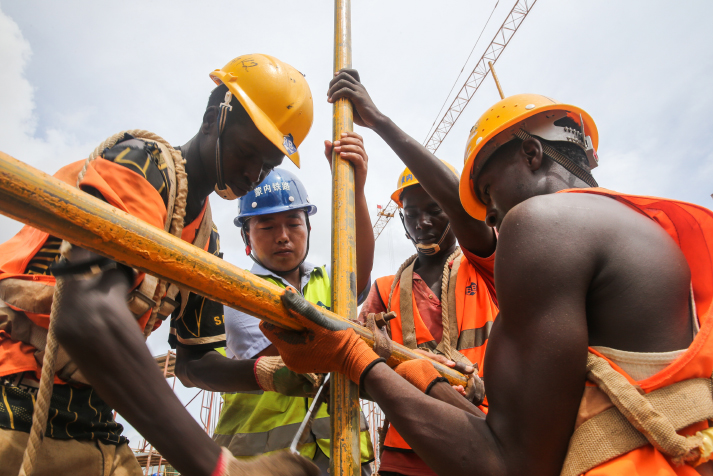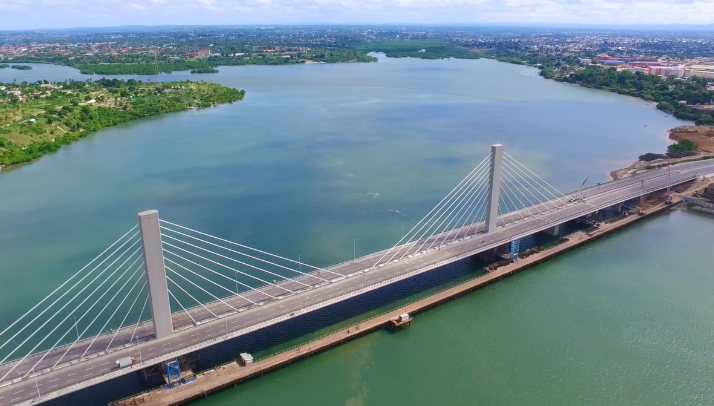As agreed by both China and Africa, China will host the Beijing Summit of the Forum on China-Africa Cooperation (FOCAC) this September. Wang Yi, Chinese State Councilor and Foreign Minister, made the announcement on the sidelines of the Meeting of BRICS Ministers of Foreign Affairs in South Africa on June 4.
The upcoming summit will be themed Win-Win Cooperation and Join Hands to Build a Closer Community with a Shared Future for China and Africa. Wang said China and Africa will endeavor to integrate the Belt and Road Initiative, the 2030 Agenda for Sustainable Development of the UN, the Agenda 2063 of the African Union (AU) and the development strategies of various African nations to create more opportunities for mutually beneficial cooperation, and to open up new prospects for common development.

A Chinese engineer collaborates with Kenyan workers on the construction of the Mombasa-Nairobi Railway on April 9, 2016 (XINHUA)
The First FOCAC Summit was held in Beijing in 2006, and 12 years on leaders from China and Africa will once again gather in Beijing to usher in a new era of Sino-African cooperation. This summit, the third in FOCAC's 18-year history, demonstrates the value that China places on Sino-African ties and promises to drive the China-Africa friendship to new historic heights.
Proactive attitude
Since Chinese President Xi Jinping proposed the Belt and Road Initiative five years ago, more than 100 countries and international organizations around the world have shown interest, of which more than 80 have signed cooperation agreements with China involving Belt and Road projects. The initiative, consisting of the Silk Road Economic Belt and the 21st-Century Maritime Silk Road, aims to build a trade and infrastructure network connecting Asia with Europe and Africa along and beyond the trade routes of the ancient Silk Road.
Africa is a continent rich in resources with great market potential, but it is in dire need of robust infrastructure. It is proactively participating in Belt and Road construction with other countries along the routes in the hope that its economy can make a leap.
As Wang said when he visited Africa in January, the African continent must be at the heart of the Belt and Road Initiative and must not be left behind by China or the wider world in terms of development.

The China-built Nyerere Bridge, linking the business area of Tanzania's largest city Dar es Salaam to the Kigamboni district across the Kurasini creek, is the largest cable-stayed cross-sea bridge in sub-Saharan Africa (XINHUA)
FOCAC was established in October 2000, 13 years prior to the proposal of the Belt and Road Initiative. China pursues common, intensive, safe, open and green development in its cooperation with African countries, which neatly dovetails with its commitment to innovative, coordinated, green and open development that is for everyone at home. Nearly 18 years of evolution have established FOCAC as a symbol of international cooperation, which allows the organization to provide precious experience to the Belt and Road construction across different regions and fields.
Advancing interconnection
Inadequate infrastructure is a bottleneck that constrains Africa's economic development. Poor transport facilities and substandard roads have created exorbitant costs in domestic and regional trade, as well as impeding foreign investment.
Financing for Africa's infrastructure needs faces an annual shortfall of at least $20 billion. In addition, most African countries have a low level of industrialization, and the contribution of industry to their economies is correspondingly small. However, Africa is a continent with abundant resources, low labor costs and great market potential, while China has significant advantages in capital, technology and equipment, as well as a wealth of experience in transforming from an agricultural to an industrial society. At a time when China is undergoing a fundamental phase of economic transition and upgrading, there is plenty of high-quality capacity and advanced equipment and technology available for outward transfer, much of which is ideally suited to Africa's needs.
Just as the Chinese people harbor the Chinese dream of national rejuvenation, the African people hold the African dream of achieving development and alleviating poverty. Connectivity and industrialization are essential preconditions and the only path toward the realization of this dream. The Belt and Road Initiative can work in harmony with Africa's development strategy for the 21st century. It can provide new drive for the sustainable development of Sino-African relations and help Africa take a step forward, blazing a new trail for South-South cooperation.
China and the AU signed a memorandum of understanding (MOU) on infrastructure construction cooperation on January 27, 2015. According to the MOU, under the strategic framework of Africa's 2063 Agenda, China will enhance cooperation with African nations on railways, highways, regional airlines and industrialization to promote African integration. Chinese enterprises have already launched construction projects in these fields in countries such as Ethiopia, Djibouti, Kenya and Nigeria.
For example, the Huajian Group, a shoe producer from Dongguan in south China's Guangdong Province, began operating in the Ethiopia Oriental Industrial Park at the end of 2011. By the end of 2017, Huajian had become the largest private Chinese investor in Ethiopia, generating $122 million of foreign exchange income and creating 7,500 new jobs for the local population. The company produces over 5 million pairs of women's shoes each year, accounting for more than 65 percent of the Ethiopian shoe industry's total exports. On September 1, 2017, the Ethiopian Government awarded Zhang Huarong, Chairman of the Board of the Huajian Group, the honorary title of "Father of Ethiopia's Industry" for his contribution to the country's development. Inspired by its success in Ethiopia, the Huajian Group plans to invest in Rwanda, Nigeria and elsewhere in Africa in the future.
Driving force
At the FOCAC Johannesburg Summit in South Africa in December 2015, China and participating African countries agreed to carry out 10 major cooperation plans in the following three years. The ultra-intensive plans, worth around $60 billion, cover industrialization, agricultural modernization, infrastructure construction, finance, green development, trade and investment facilitation, poverty alleviation, public health, people-to-people exchanges, and peace and security. The foremost of these is cooperation on industrialization to promote the progress of African development. In order to facilitate this, the first China-Africa Capacity Cooperation Fund—worth $10 billion—has been set up, alongside the Special Loan for the Development of African Small and Medium-Sized Enterprises and the China-Africa Development Fund each with a capital of $5 billion.
Industrial cooperation between China and Africa has already begun to bear fruit. As one of the first African countries to join China in international industrialization cooperation, Tanzania has signed a framework agreement with China on supporting key projects of the country's ongoing five-year plan.
The construction of infrastructure and industrial parks is also making rapid progress. China has assisted Africa in building several railway lines, including one connecting the port city of Mombasa in Kenya to its capital Nairobi, another connecting Addis Ababa, the capital of Ethiopia, to Djibouti, and a third connecting Angola and Nigeria.
As Kenyan President Uhuru Kenyatta said at the opening ceremony of the Mombasa-Nairobi Railway on May 31, 2017, the new line is "one of the cornerstones to Kenya's journey of transformation to an industrial, prosperous and middle-income country."
The author is a researcher with the Institute of West Asian and African Studies, the Chinese Academy of Social Sciences, and a senior researcher with the Charhar Institute